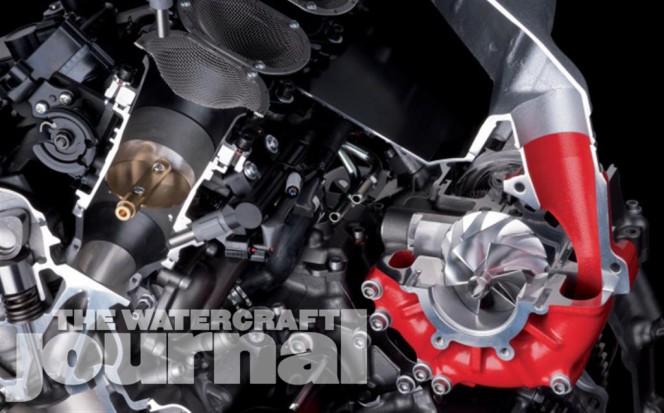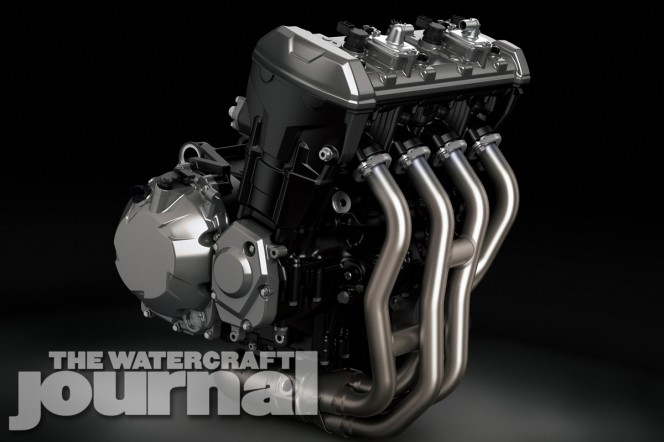The 2015 Kawasaki H2R is a big deal, and not just for the world of motorcycles. (But more on that later.) Introduced at INTERMOT 2014, the motorcycle show in Cologne, Germany, the 2015 Ninja H2R is not only closely tied to Kawasaki’s long praised legacy of H2 (and race-bred R-series H2’s), but works to establish the brand’s strong identity within the world of evermore exotic and technologically advanced motorcycles.
Hellbent on producing the next stage in evolution in supersport motorcycles, Kawasaki devoted untold months and years in development of the race track-only H2R. Drawing heavily from the best trellis construction designs, wind tunnel-honed aerodynamic cues and on-board technologies, the H2R provides “the kind of acceleration no rider has experienced before,” with a chassis and aerodynamics that deliver “unflappable stability,” “cornering performance,” and what Kawasaki calls “an accommodating character.”
So what does that mean? As one could imagine, Kawasaki has included the most, as Cycle World’s Kevin Cameron stated, “civilizing electronics, including KTRC traction control, KEBC engine braking control, and KLCM launch control.” Yet, what will draw your attention more than anything else is the H2R’s 998cc centrifugally-supercharged 1-liter four-stroke plant producing an almost maniacally-laughable 300 horsepower.
We at The Watercraft Journal first jumped on the announcement of this wicked new powerhouse back in November of 2013. Introduced at the Tokyo Motor Show, the compact-yet-familiar design of the ZX-10R engine forgoes the traditional roots-style supercharger for a shaft-driven, scroll-type centrifugal unit.
According to Cameron’s assessment, “They show the supercharger drive packaged into the space behind the cylinder block of a transverse in-line engine. Gear teeth cut into one of the engine’s flywheels turn a jackshaft behind the cylinder block. That shaft in turn drives a shaft above it, ending in a compact planetary step-up drive just before the centrifugal impeller itself. Compressed air output from the blower’s scroll housing flows upward, pressurizing the intake airbox above it. We can expect normal-looking throttle bodies and bellmouth intakes, projecting up into the box from the engine’s cylinder head.”
Although the impeller wheel appears to be compact, the two-speed drive to the supercharger shaft reveals the plant’s potential. Where the blower to deliver a modest 5 psi of boost (that’s 5 psi above atmospheric) at 6,000 rpm, Cameron extrapolates, it would be trying to deliver 20 psi boost at 12,000. And that would make the H2R almost completely unrideable. Hence, the need for all the “torque-flattening” technology.
So again, what does this vünderbike have to do with the future of Kawasaki’s JetSki division? Nothing, yet. Yet, as savvy enthusiasts know, technology has a funny way of trickling down. Sea-Doo’s iBR system, which was first introduced in 2009 on the top-of-the-line RXT 255 iS and GTX Limited 255 iS, is now standard equipment on all Sea-Doo vehicles (besides the GTS and optional equipment for the Spark).
Yamaha too, has upped the technology ante with their user-friendly RiDE dual-throttle braking and reverse system, also making its way through almost every runabout in the company’s lineup (apart from the FZ series and entry-level V1 units). This of course, has done nothing but increase Yamaha’s customer appeal and made the battle for market share dominance all the more heated.
Currently, only the Eaton-supercharged Ultra models benefit from the revised ZX-15R engine architecture introduced for the 2014 models. The increase in engine cooling through larger water jacketing, multi-port under-piston oiling, larger oil galleys and a larger oil cooler (not to mention revised cast pistons, lightweight composite intake manifold and an improved ECU mapping) has not only increased engine efficiency but longevity over the previous 300X model.
Unfortunately, the 310X powerplant remains a hefty piece of equipment. With the compact-yet-equally-potent ZX-10R engine in the H2R weighing a scant 100-pounds (unconfirmed), future Ultras could handily benefit from an immediate weight savings with only losing 10 horsepower. And as the scroll-type centrifugal supercharger produces far less heat than the traditional roots blower, internal engine temperatures would only improve.
Of course, if the H2R and subsequently following street-legal H2 are to become Kawasaki’s “halo” vehicles for the brand, we can only aspire for the H2R’s fighter jet razor-sharp design cues and materials to make their way to the brand’s watercraft division. An all black-and-carbon with Kawasaki Green pin stripping Ultra 300X-R JetSki would be a phenomenal creature to behold. And hope ever springs eternal for a rebirth of the STX-R as a carbon-decked murdered-out 1,000cc centrifugally-supercharged closed course buoy burner.
Alas, we will have to patiently wait and see how well the H2R is received by the motorcycle industry. Yet, if sales of the H2R and eventual H2 are as strong as the attention the bike is receiving from the media, we don’t think we’ll have much to worry about. If and when a ZX-10R powered JetSki is actually realized is another issue altogether. But understanding the brand’s slant towards integrating family DNA in all of its products, we remain positive that good things are coming from the “good times” company.






















